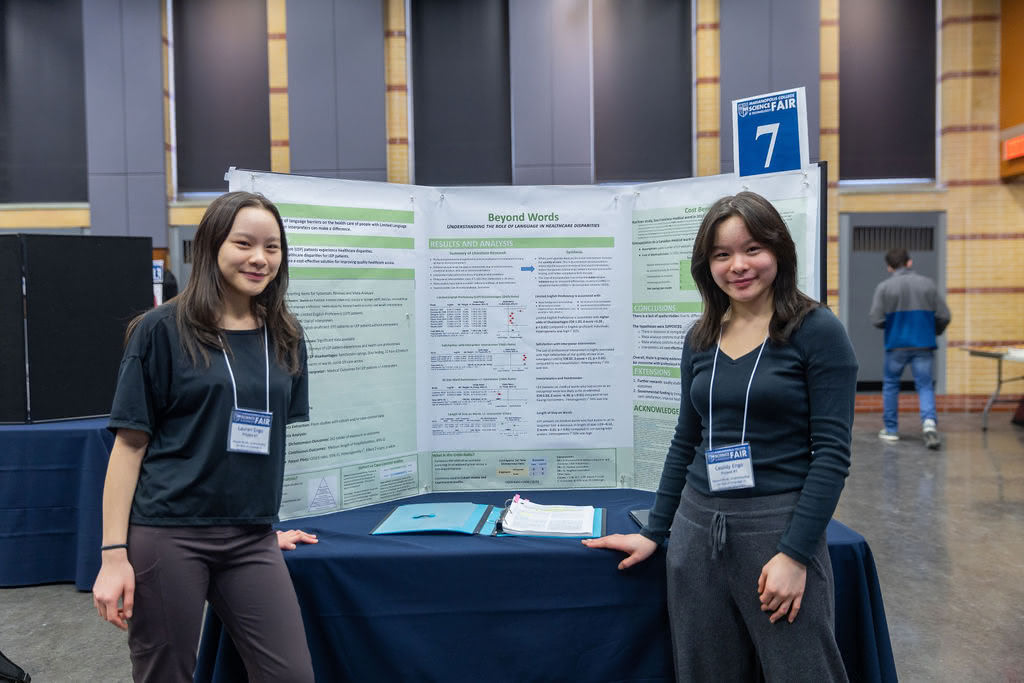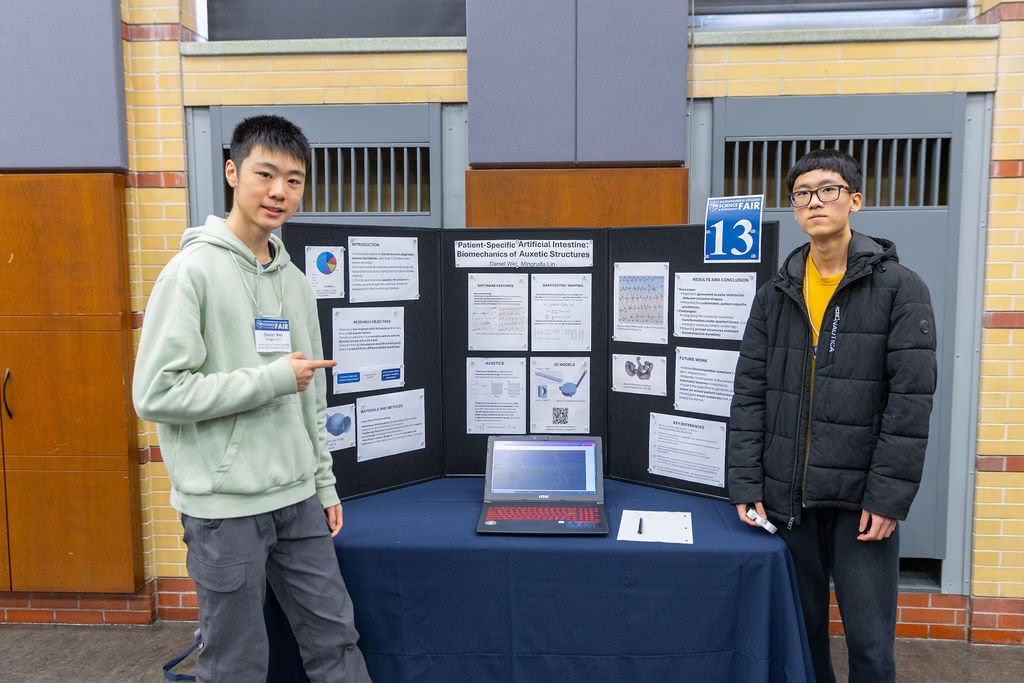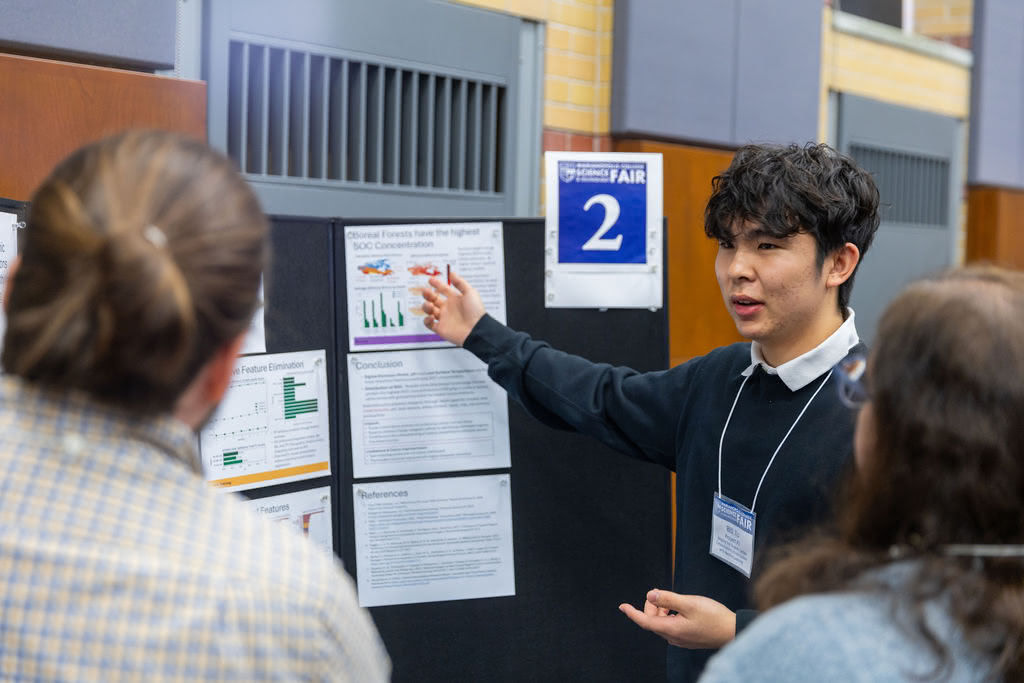Students Earn Top Honours at 2025 Montreal Science Fair
Marianopolis students showcased their research talents at the 2025 Montreal Regional Science and Technology Fair, held at Pierrefonds Community High School from March 23 to March 25.
All four research projects presented by the Marianopolis delegation earned Highest Distinction and will advance to the provincial final early next month.
Health Science students Cassidy Engo and Lauren Engo won the Collegiate Gold for their project on the impact of language barriers on medical services and the use of professional interpreters in healthcare settings.
Pure and Applied Science students Mingruifu Lin and Daniel Wei earned the Collegiate Bronze for their research on the biomechanical processes involved in creating artificial intestines.
Honours Pure & Applied Science student Bill Xu received the McGill University Oceanic Award for his research on the use of machine learning to measure soil organic carbon concentrations and its potential implication for conservation policies.
Honours Health Science students En Hui Ye and En Zhou Ye received the Statistics and Math Awards for their work on developing independent cloaking devices.
The College congratulates the students on their impressive performance and extends its thanks to professors Simon Sabik, Mariah Hamel, François Charette, and Liliane Halab for the invaluable support and guidance they provided throughout the process.
Learn more about the award-winning projects developed by her students below!

Beyond Words: Understanding the Role of Language in Healthcare Disparities
Cassidy Engo and Lauren Engo
Canada is a linguistically diverse country with 23% of the population foreign-born. 14% of Quebec residents have a mother tongue other than English or French. Language barriers create major healthcare challenges for allophones, leading to poorer satisfaction, more return visits, increased testing and higher cost of care. This study reviewed the current scientific literature to quantify the impact of language barriers on health care and whether interpreters can make a difference. PRISMA model of literature searched online databases on PubMed (MedLine), Cochrane, Springer, MDPI, StatsCan, and HealthCan. Using PICO (Patient, Intervention, Comparison, Outcome), journals were chosen on the criteria of patients with LEP (Low English Proficiency), health care disparities, if using interpreters and cost benefits.
Overall, this study supports the growing consensus that people with language barriers have poor health metrics that can be overcome with professional interpreters. Changes in demographic trends in Canada highlight the importance of ensuring effective language communication in healthcare settings, where accurate information exchange ensures high quality of care, patient safety, and good clinical outcomes. However, access to interpretation services in Canadian healthcare settings is not universal and is particularly limited in Quebec. This study proposes governmental funding to integrate interpreter services at hospitals to enhance patient care satisfaction, improve healthcare outcomes and reduce costs.

Patient-Specific Artificial Intestine: Biomechanics of Auxetic Structures
Daniel Wei and Mingruifu Lin
Colorectal cancer (CRC) is the third most commonly diagnosed cancer globally, with over 1.9 million new cases and approximately 930,000 deaths estimated in 2020. Despite advancements in tissue engineering, current research predominantly focuses on replicating the intestinal absorption layer, with limited progress in recreating the muscular layer essential for bowel motility. In effect, the organicity of biological macrostructures often cannot be broken down effectively into manufacturable units. Current solutions like colostomy bags are impractical and fail to fully replicate natural intestinal function, highlighting the need for more functional alternatives.
This research aims to develop a bio-inspired, patient-specific artificial intestine that can be folded from a flat auxetic lattice generated upon the input of a desired 3D shape (such as a colon), which approximates smooth peristaltic movements through expansion and contraction from each auxetic unit. The algorithm can be generalized for other applications beyond prostheses. A combination of computational testing and visualization, and 3D printed prototypes are used to verify the method’s effectiveness.
The result of this research is an algorithm that processes data from the scanned model of a colon to generate a 3D printable flat mesh that morphs under the propagation of tension or compression along multiple control units located on its boundary. By the 2D nature of the printed surface which folds into 3D, the research impacts material engineering by preventing problems related to supports in 3D printing involving more vertical structures, allowing for more complex shapes to occur. It also provides options for the development of new types of prostheses that better reproduce organic movement. When combined with advanced absorption layer technologies, this approach provides an efficient solution to the production of artificial intestines and other similar organs.

Mapping Soil Organic Carbon Concentrations across Canada with Machine Learning
Bill Xu
Soil organic carbon (SOC) is fundamental to both soil fertility and climate regulation through its role in carbon sequestration and greenhouse gas emissions. While its spatial distribution across vast regions like Canada remains underexplored, understanding SOC concentration patterns is crucial for climate change mitigation, particularly since areas with high SOC concentrations are vulnerable to significant carbon losses when disturbed.
Using machine learning approaches, this study aims to model and map SOC concentrations at three depths (0-10 cm, 10-30 cm, and 30-60 cm) across Canada’s landmass. The analysis integrated 39,323 soil samples from the World Soil Information Service spanning two decades with satellite-derived environmental features from Google Earth Engine. Through recursive feature elimination, 20 features were selected to generate random forest regression models for each depth. The models achieved R² values of 0.44, 0.31, and 0.35 for their respective depths, with elevation, pH, clay content, and land surface temperature emerging as key predictors of SOC concentration. Canada’s 250m resolution maps demonstrate that boreal forest/taiga biomes contain the highest soil organic carbon (SOC) concentration reserves, while temperate grasslands contain the lowest. These findings provide guidance for developing targeted conservation policies in carbon-rich regions.

High-Definition Independent Cloaking Device
En Zhou Ye and En Hui Ye
Cloaking devices and their design have been evolving rapidly in the last couple of decades with the discovery and use of a variety of apparatus to achieve cloaking of a desired region. The most advanced systems rely mostly on digital tools and metamaterials, at the cost of cloaking clarity and transparency. Previous systems, which used traditional light manipulating tools such as mirrors and lenses, were able to achieve high-quality cloaking. However, those devices are cumbersome, and their applications are limited.
The device presented herein addresses all these issues by being an independent high-definition cloaking device. This system has similar mathematical frameworks as the traditional design with flat mirrors, while replacing said mirrors with parabolic and hyperbolic mirrors. The novel idea is to take light from the light source space and reproject it in the observer space while using the least space possible. The device has an overall structure of an octahedron, where each side is parabolic in shape and have reflective abilities. Hyperbolic mirrors are attached to the parabolic surfaces’ foci and oriented to direct accumulated light to a partner mirror where it would be projected to the observer, rendering the space within the object invisible.
In this paper, existing systems will be thoroughly analyzed, taking into consideration advantages and drawbacks. This paper will also present results and abilities of the High-Definition Independent Cloaking Device (HD-ICD) during simulation using Blender. The novel design is shown to be capable to achieve a high-quality cloaking of a specific region.